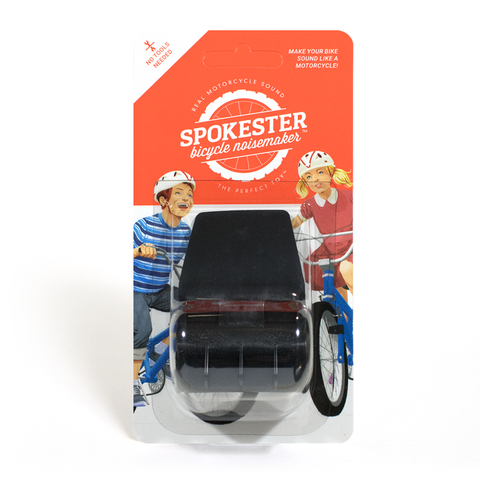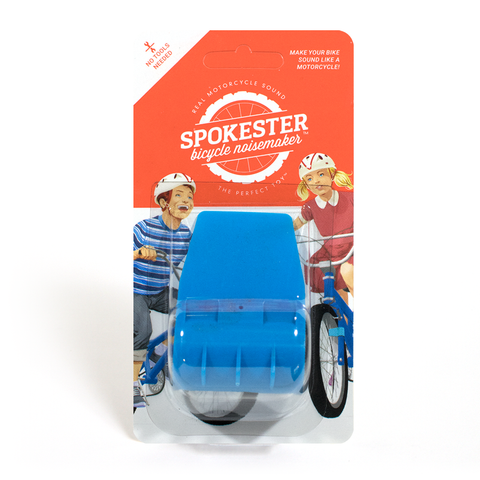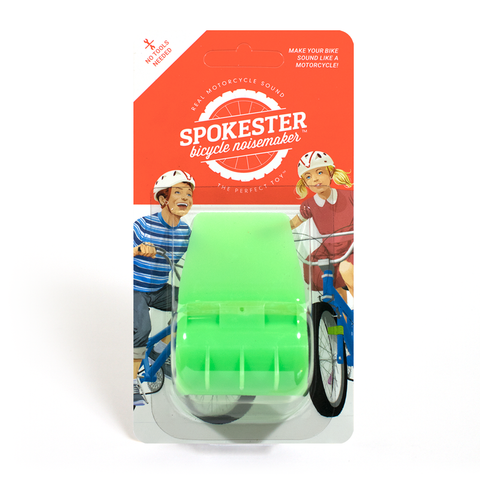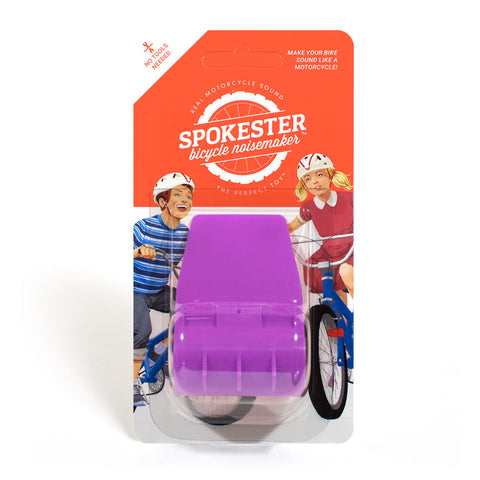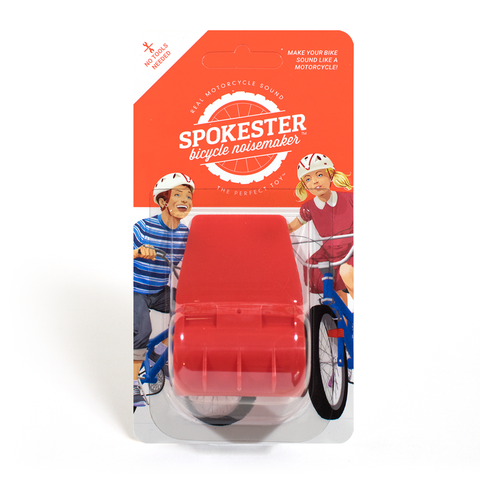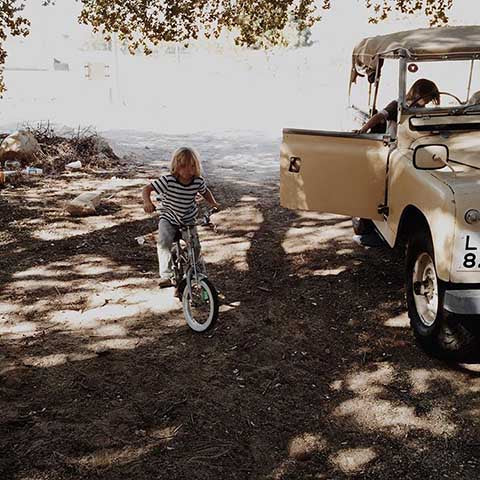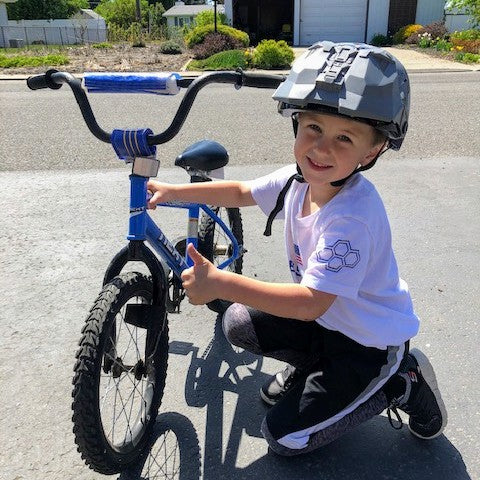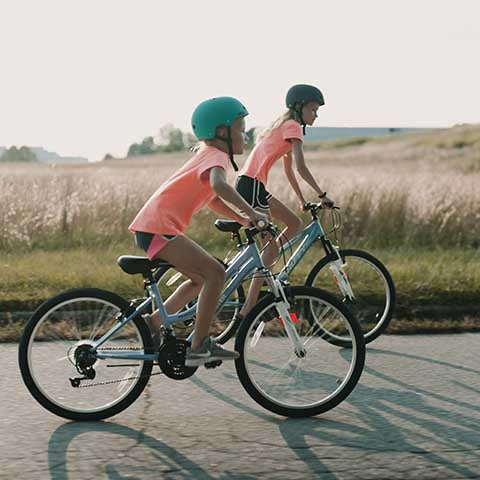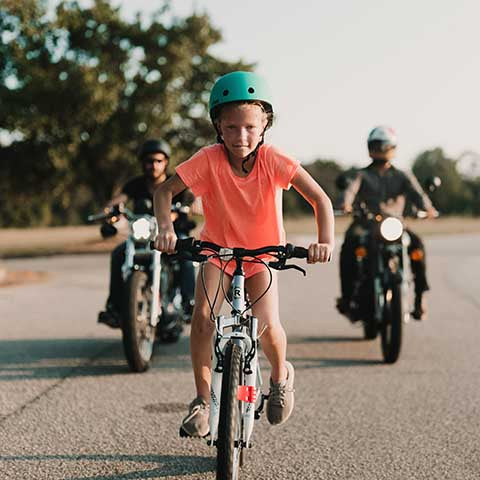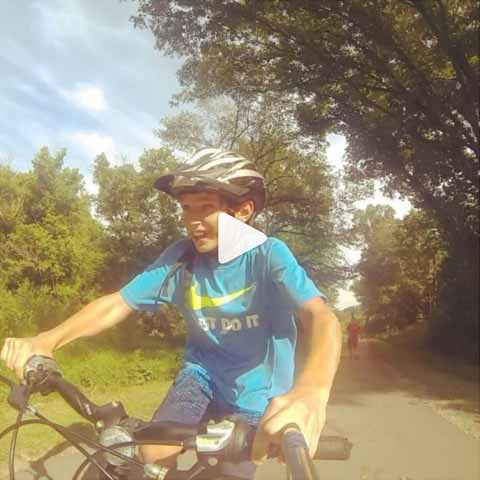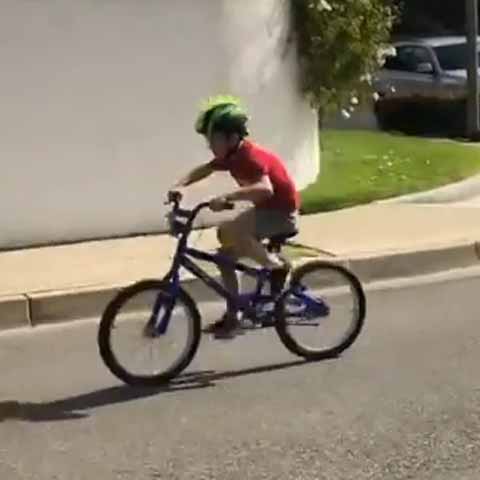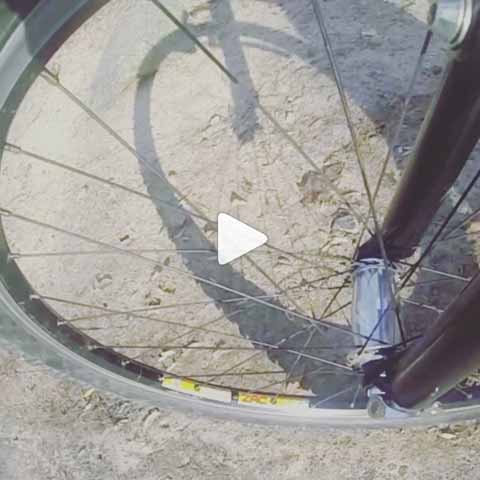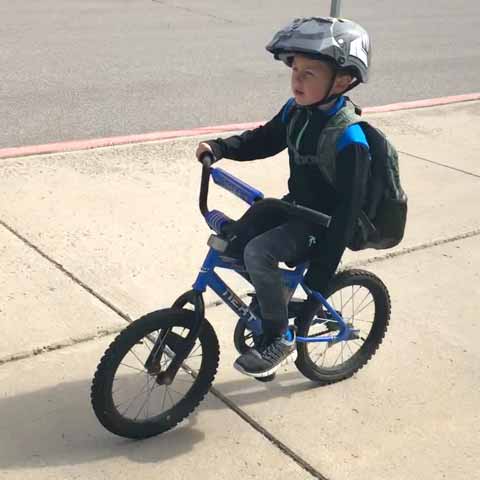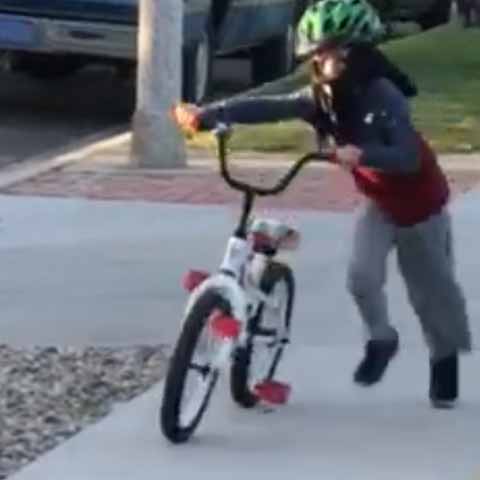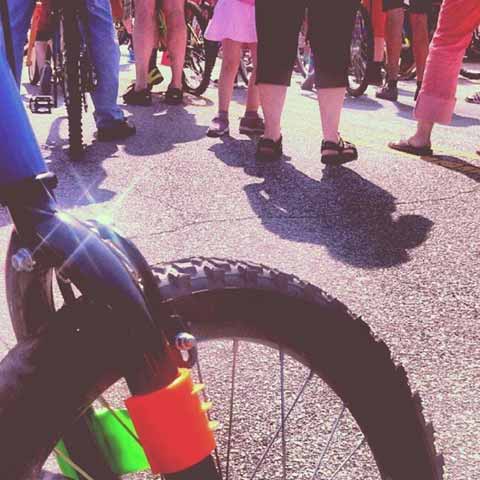Types of Kids' Bikes – the Busy Parent’s Guide
Q-factors, gain ratios, and chainstays… oh my!
Terms like these sound more like something you'd hear whizzing around a jet propulsion lab than a neighborhood block party. But, believe it or not, they all apply to today's bicycle market, including kids' bikes.
Gone is the era of buying Junior a bright-red two-wheeler with streamers and a basket and calling it a day. In 2018, the array of options to choose from is all over the map. That may be nice for the little ones, but sometimes it can be overwhelming for parents who are simply trying to figure out the best bikes for their own kids. And when it comes to actually trying to research styles, features, and brands, you can always rely on Google for information overload!
Don't worry, we're here to help. Life in the 21st Century already gives you enough to stress about on a daily basis, let's not make this harder than it needs to be. After all, cycling should be fun! This article breaks down the kinds of bikes you can expect to shop for over the years. We go further into how children's ages and sizes come into play in another post, but for now we'll focus on the fundamentals of the bikes themselves.
So, from diaper phase to daredevil stage, let's take a look at the main models you'll come across when picking out a bike for your tyke.
Bikes for infants and toddlers
Parents quickly learn that kids develop at different speeds. Little Jenny may be ready to cut the tether more quickly than Little Bobby who's two months older. For that reason, we'll start at the very beginning and move our way up to tiny-cyclist-in-training.
Child Bike Seat
 Also called a baby seat, a child bike seat works just like its automobile counterpart. Equipped with a harness to keep your little one safe and comfortable, the seat is securely mounted over the rear wheel of an adult bike. This is a great option for active parents with very young children who aren't quite ready for their own ride.
Also called a baby seat, a child bike seat works just like its automobile counterpart. Equipped with a harness to keep your little one safe and comfortable, the seat is securely mounted over the rear wheel of an adult bike. This is a great option for active parents with very young children who aren't quite ready for their own ride.
Things to keep in mind:
- Adult bike
- Make sure your own ride is compatible with the child's seat since not all bikes have the right features to be able to attach it.
- Seat position
- While most seats attach in the rear, some are made to fit onto the front of the adult bike below the handlebars. The decision is yours, so choose which one you feel most comfortable with.
- Child fit
- It's always a good idea to make sure your child fits comfortably in the seat before committing to it. For instance, some backs are lower than others, which can impact head support and shoulder-strap movement.
- Popular brands
- WeeRide, Thule, Topeak, iBert, Hamax, Bellelli, Peg Perego
Bicycle Trailer
 Similar to the child bike seat, bike trailers require exactly zero effort on the part of your child. But, rather than sitting behind you on your bike, your son or daughter is resting comfortably in a two-wheeled cart attached to your frame and towed by you. These work particularly well for longer trips since they protect their precious cargo from the elements and are usually more comfortable, which leads to the always-appreciated naptime. Some models come built for two kids, and others can even be converted to strollers for the ultra-efficient mom and dad.
Similar to the child bike seat, bike trailers require exactly zero effort on the part of your child. But, rather than sitting behind you on your bike, your son or daughter is resting comfortably in a two-wheeled cart attached to your frame and towed by you. These work particularly well for longer trips since they protect their precious cargo from the elements and are usually more comfortable, which leads to the always-appreciated naptime. Some models come built for two kids, and others can even be converted to strollers for the ultra-efficient mom and dad.
Things to keep in mind:
- Weight
- The extra weight of the trailer (especially with multiple pups) will impact speed and maneuverability. Add in the increased length and width of the overall setup with a trailer, and you need to make sure you're comfortable with your handling.
- Terrain
- Gliding through town versus off-roading it through the woods is as different for them as it is for you. If you plan on riding rough, make sure your trailer is fit for multisport use.
- Versatility
- Many trailers these days can convert to joggers and strollers. Finding a model that's comfortable for you and your children can be a cost-efficient and space-saving option, particularly for city dwellers.
- Popular brands
- Wike, WeeRide, Burley, Thule, Weehoo, Hamax, Croozer, Schwinn
Trailer Cycle
 We know what you're thinking and, no, we didn't just cover this. A trailer cycle is not the same thing as a bicycle trailer. Also called a trailer bike (and sometimes referred to by specific brand names like Tagalong and Trail-a-Bike), a trailer cycle is essentially a bike without the front wheel. Instead of operating independently, the cycle's handlebars, seat, and wheel attach to the parent's frame from behind in a way that allows it to pivot when turning. This gives your child a chance to pedal and move slightly more freely of you while you maintain balance for both. He or she now has some skin in the game without the risk that comes with total two-wheeled freedom.
We know what you're thinking and, no, we didn't just cover this. A trailer cycle is not the same thing as a bicycle trailer. Also called a trailer bike (and sometimes referred to by specific brand names like Tagalong and Trail-a-Bike), a trailer cycle is essentially a bike without the front wheel. Instead of operating independently, the cycle's handlebars, seat, and wheel attach to the parent's frame from behind in a way that allows it to pivot when turning. This gives your child a chance to pedal and move slightly more freely of you while you maintain balance for both. He or she now has some skin in the game without the risk that comes with total two-wheeled freedom.
Things to keep in mind:
- Attachment
- Trailer cycles typically attach to the seat post of the adult bike. Make sure there's ample room (at least 2" in most cases) and post thickness for the hitch. This leads to a more secure fit and less wobble for your kiddie.
- Trailer style
- The majority of trailers are made to simulate the kind of upright riding posture children will eventually reach on their own. However, there are models out there that place children in a "recumbent" position. Unlike other trailers these usually offer straps, so if safety is a priority then this may be a consideration.
- Handlebars
- Some models feature adjustable handlebars that can move up or down the attachment bar, or pivot forward or backward to accommodate children of different heights and reaches. If yours is sprouting like a happy little weed or you have more than one in your den, you may want to keep an eye out for this feature.
- Popular brands
- WeeRide, Burly, Weehoo, Trail-a-Bike
Balance Bike
 Children develop the necessary coordination for self-cycling at different rates. Some need to stick to safer options like tricycles and three-wheelers until their early motor skills catch up. Others begin experimenting with their first true bike around age 2 or 3. For decades, the intermediate step has defaulted to training wheels, a term that's become so ingrained in society that it's now a euphemism for any sort hand-holding with new activities. But, nothing lasts forever, and even though they still get the job done, training wheels are now becoming more of an optional step thanks to the introduction of pedal-less balance bikes.
Children develop the necessary coordination for self-cycling at different rates. Some need to stick to safer options like tricycles and three-wheelers until their early motor skills catch up. Others begin experimenting with their first true bike around age 2 or 3. For decades, the intermediate step has defaulted to training wheels, a term that's become so ingrained in society that it's now a euphemism for any sort hand-holding with new activities. But, nothing lasts forever, and even though they still get the job done, training wheels are now becoming more of an optional step thanks to the introduction of pedal-less balance bikes.
Balance bikes have caught on quickly with children as young as 2 because they teach the one thing training-wheel bikes can't: balance. If kids have no fear of tipping over, they have no motivation to learn how not to! By using only their feet to propel themselves and brake, youngsters naturally learn how to steer and counter-steer, shift their weight, and stay upright as they move forward. This Flintstones-like process builds confidence faster, meaning your little strider rider will be pleading for pedals in no time.
Things to keep in mind:
- Size
- This may seem like a no-brainer, but rider size matters. Balance bikes are made in all kinds of sizes that accommodate not just toddlers, but also older special-needs youths and even adults who are just learning how to ride. With this range, make sure your bike is a good fit.
- Longevity
- Balance bikes are very much transition bikes. Depending on when your child first hops on one, he or she may not take very long at all before it's time for pedals. This can be a consideration when determining how much you want to invest based on how long it will be used.
- Brakes
- Yes, balance bikes are meant to be started and stopped with your feet. No, that doesn't mean they don't come with brakes. Certain models do feature hand brakes, which could accelerate that part of the learning curve for more coordinated kids.
- Popular brands
- Strider, Woom, REI Co-op Cycles, Yedoo, TootScoot, GT, Giant
Bikes for big kids
Watch out, world, we've got another one taking to the streets! We're talking pedals, drivetrains (aka gears and chains), and a newfound sense of independence. At this point, fit becomes much more important, and this is based primarily on wheel size. The standard diameter of adult-bike wheels is 26", occasionally going up to 29" for certain styles like serious off-road mountain bikes. Children's bikes, on the other hand, come in four common sizes of 12", 16", 20", and 24". Some manufacturers even make 14" and 18" versions to further smooth the progression. Although bike brands do offer suggestions for sizing by age, given children sprout up at different speeds it's actually more important to base fit on each kid's height and inseam. Comfort and safety are the most important factors to consider. You never want to buy your child a bike he or she can "grow into." We talk more about sizing your kid's bike by height and inseam in another article, complete with easy-to-follow measurement charts.
The other big consideration you have as a parent once your child is ready for the big leagues is braking. For most 12" to 16" bikes, coaster or "back-pedal" brakes are the norm. These are easier to pick up and require less coordination than hand brakes. Plus, they're more convenient for youngsters whose hands haven't grown quite large enough to be able to effectively activate a hand brake. But, kids have a natural tendency to want to pedal backward when developing balance control, which can lead to inadvertent stops and falls. Since backpedaling is part of adult cycling for a variety of reasons anyway, it's best to move on to hand brakes as quickly as your child's hand-eye coordination allows.
With these things in mind, let's take a look at the next rung on life's bicycle ladder.
small-wheelers-and-middle-wheelers
 In automobile terms, small wheelers are your base model. Small wheels (usually 12" to 14") and coaster brakes are the main features of your pup's first foray into big-kid bike land. One important area to point out at this juncture is bike fit given that a child's first pedal bike is slightly different in this respect. With the transition from balance bike or other training models, kids still need to be able to stop with their feet if necessary. Therefore, it's important that your child be able to sit comfortably with his or her feet fully touching the ground. As we'll see, this is the last time you'll want to size the bike this way.
In automobile terms, small wheelers are your base model. Small wheels (usually 12" to 14") and coaster brakes are the main features of your pup's first foray into big-kid bike land. One important area to point out at this juncture is bike fit given that a child's first pedal bike is slightly different in this respect. With the transition from balance bike or other training models, kids still need to be able to stop with their feet if necessary. Therefore, it's important that your child be able to sit comfortably with his or her feet fully touching the ground. As we'll see, this is the last time you'll want to size the bike this way.
We like to use the term middle wheeler to describe bikes whose wheel sizes sit in the middle of the pack, usually 16". Now you're starting to see more options with hand brakes and freewheel hubs, which let kids pedal backwards. This is an important milestone in their riding competency. Since a middle wheeler is often the child's second pedal bike, the feet should no longer be used as a brake. Therefore, look for a bike that can adjust to allow your pint-sized housemates to touch the ground using only their tippy toes while seated rather than their full soles. This allows them to get proper extension as they pedal, yet another step toward cycling mastery. As with all other levels, though, make sure your individual child has proven himself or herself when it comes to balance, steering, and braking. This is no time to play keep-up with the Joneses.
Things to keep in mind:
- Simplicity
- For your toddler's first "real" bike, odds are that he or she's going to be thrilled no matter what you bring home. Don't agonize over specific features, just find one that the tyke's going to like and sizes well.
- Assembly
- A number of children's bikes come with "some assembly required." While most are fairly pain-free, if you're not confident in your ability to construct a flawless ride, then don't chance it. Either buy a fully-built model or take it to a shop for some help.
- Gender
- Many larger manufacturers continue to make separate bikes for boys and girls, whereas smaller ones are starting to lean toward gender-neutral models. At this age, the difference is minimal, and the only way Timmy will notice is if he gets a pink Barbie bike for Christmas. Don't sweat it otherwise.
- Popular brands
- Huffy, Giant, Razor, Hot Wheels, Raleigh, Tauki, RoyalBaby
Cruiser bikes
 Okay, now we're cooking. Bike models are beginning to diversify in terms of complexity and style. Our first stop on the last level of the pre-adult riding game is cruiser bikes. Fun, comfy, and at times even flashy, kid cruiser bikes are meant for casual riding around the neighborhood. Simplicity is the key here. Most cruisers are single-speed bikes with wider tires for better stability. Adult versions are often called beach cruisers, so keep an eye out for this terminology as you're browsing selections.
Okay, now we're cooking. Bike models are beginning to diversify in terms of complexity and style. Our first stop on the last level of the pre-adult riding game is cruiser bikes. Fun, comfy, and at times even flashy, kid cruiser bikes are meant for casual riding around the neighborhood. Simplicity is the key here. Most cruisers are single-speed bikes with wider tires for better stability. Adult versions are often called beach cruisers, so keep an eye out for this terminology as you're browsing selections.
Things to keep in mind:
- Style
- Cruiser bikes are all about cruising! Since we're not talking about trails or tricks, your biggest goal should be finding a bike in a color, shape, and style that your child really likes.
- Seat
- Built for comfort, cruiser bike seats come in multiple shapes and sizes. Some are wider with more cushion, and some are longer and able to fit two people ("banana seat"). This is probably one of those times you ask your children their preference before buying.
- Simplicity
- Made for easy riding around neighborhood, through the park, or on the boardwalk, cruiser bikes are basic. Most kids' versions have coaster brakes and a single gear to keep it simple. Remember this for an uncomplicated shopping process!
- Popular brands
- Schwinn, Pacific, Kulana, Electra, Firmstrong
Road bikes
 Road bikes are meant for, well, roads. The frames and tires are built for flat surfaces. If Jimmy spends most of his day riding over rocks in the backyard, this is probably not the model you're looking for. If he's gunning for the peloton, that's a different story. Road bikes can feature either flat handlebars for upright riding positions or drop-bar handlebars for a forward-leaning, aerodynamic posture suited for faster riding.
Road bikes are meant for, well, roads. The frames and tires are built for flat surfaces. If Jimmy spends most of his day riding over rocks in the backyard, this is probably not the model you're looking for. If he's gunning for the peloton, that's a different story. Road bikes can feature either flat handlebars for upright riding positions or drop-bar handlebars for a forward-leaning, aerodynamic posture suited for faster riding.
Things to keep in mind:
- Gears
- Ahh, we've entered the wonderful world of drivetrains. Multiple bicycle gears allow your speed demon to start experimenting with different settings to control the pace. Don't overthink this. They likely won't care if it's a 6-speed or 12-speed right now, just concentrate on helping them understand the basics of shifting.
- Brakes
- Drop-bar handlebars and brakes can be a big adjustment for kids. Unless your child is absolutely ready, it may be a good idea to go with a model that has brakes on both the flat and drop-bar handlebars and let him or her ease into the drop style.
- Use
- By design, road bikes are meant for pavement or other flat, even surfaces. If the other kids in the neighborhood are wheeling it up in quarries and dirt piles, a road bike's not going to cut it. Make sure you know how your little buddy intends to use it.
- Popular brands
- Diamondback, Islabikes, Frog, Trek, Giant, Raleigh, Pinarello
Mountain bikes
 Kid mountain bikes have become a hit because of their versatility. Durably-constructed and featuring wider, knobby-tread tires for rough trail riding, these can also be used to zip around on flat surfaces, especially with multiple gears to play with. While adult MTBs can carry all sorts of special features such as suspension systems, grip shifts, and bar ends, don't worry too much about things like this for the first one. See if your kid likes the basic model, let him or her get used to it, and then go from there as activity levels increase.
Kid mountain bikes have become a hit because of their versatility. Durably-constructed and featuring wider, knobby-tread tires for rough trail riding, these can also be used to zip around on flat surfaces, especially with multiple gears to play with. While adult MTBs can carry all sorts of special features such as suspension systems, grip shifts, and bar ends, don't worry too much about things like this for the first one. See if your kid likes the basic model, let him or her get used to it, and then go from there as activity levels increase.
Things to keep in mind:
- Tires
- For a lot of kids, mountain bikes are their first specialized ride. Moving from sidewalk to singletrack can take a little time. Bikes with wider tire options tend to improve traction and stability as your child learns how to adjust to bumps and inclines.
- Gears
- Like road bikes, drivetrains are very common on kids' mountain bikes. Good thing, since this is a big feature of adult off-roaders. But, there are single-speed models, so just make sure your cubs aren't jumping into the deep end before they're ready.
- Suspension
- There's no need to invest in bikes with suspension systems until your child is ready. This adds weight, which is not what you're looking for with an intro MTB. Plus, cheap suspension forks are not the way to go, so you'll need to shell out at least a little bit if and when he or she decides to stick with it.
- Popular brands
- REI Co-op Cycles, Huffy, Diamondback, Giant, Specialized, Prevelo, Cannondale, Trek, SCOTT
BMX bikes
 Another option that's become popular in the last few generations is the BMX bike. These trace their roots back to motocross, where dirt-track racing with jumps, tricks, and banked turns require a different kind of frame and functionality. Thanks to their looks, "cool" factor, and durability, BMX bikes are now staples in parents' garages all over town. Just be ready to build the ramp that they'll inevitably want with it, dads.
Another option that's become popular in the last few generations is the BMX bike. These trace their roots back to motocross, where dirt-track racing with jumps, tricks, and banked turns require a different kind of frame and functionality. Thanks to their looks, "cool" factor, and durability, BMX bikes are now staples in parents' garages all over town. Just be ready to build the ramp that they'll inevitably want with it, dads.
Things to keep in mind:
- Type
- Dirt BMX. Race BMX. Freestyle BMX. Yes, each of these is made slightly differently to be used slightly differently, but this comes down the road. Focus on finding a basic debut BMX that your son or daughter likes and, of course, fits well.
- Weight
- Kid Knievel probably won't be soaring up and down half pipes right out of the gates, so finding a strong ultra-light bike isn't necessarily a must-do. However, lighter weight helps with learning how to maneuver, particularly on uneven terrain.
- Pegs
- Similarly, performing grinds and stalls is more of an intermediate stage, so don't be too concerned about pegs for the wheel axles on your kid's first BMX. Stunts come later.
- Popular brands
- Dynacraft, Huffy, Haro, Kent, Mongoose, Vilano, Micargi, GT
SUMMARY
There's no denying that much more needs to be considered when it comes to putting today's generation on two wheels. But, this doesn't (and shouldn't) have to be a painful experience - for you OR them! Figuring out what kind of bike is best for your whippersnapper really comes down to two main goals. First, make sure you match the bike's features with the stage of your child's physical and cognitive development. Then, choose the style best suited for how the bike will be used.
By definition, kids' bikes will ultimately outlive their purpose. That doesn't mean they need to land in the trash can, though. We also go into the best ways to recycle your little one's old bikes so that you can help keep the circle of cycling life going strong.
Good luck, have fun, and ride on!
← Older post Newer post →
